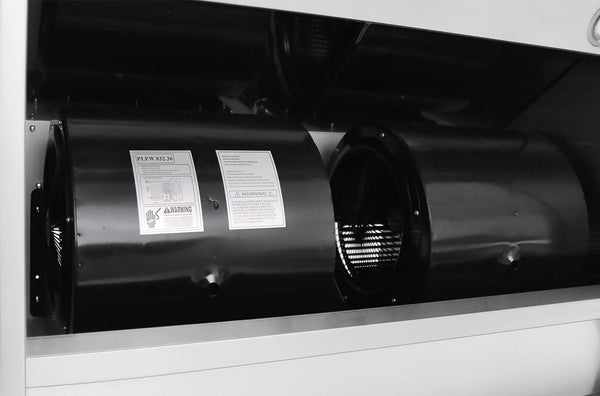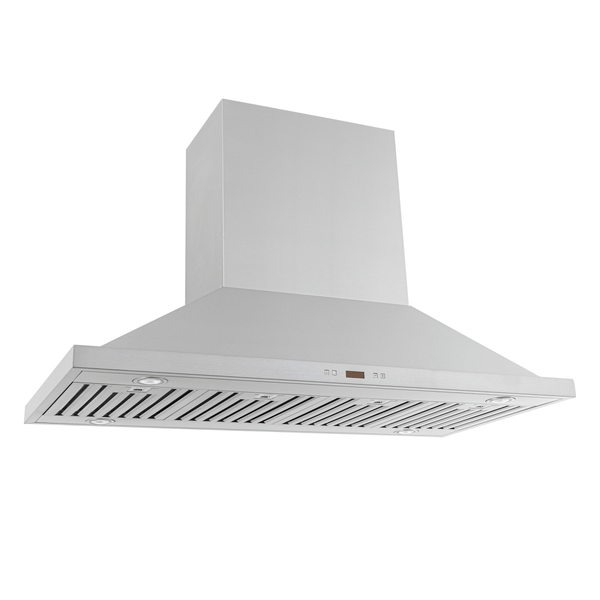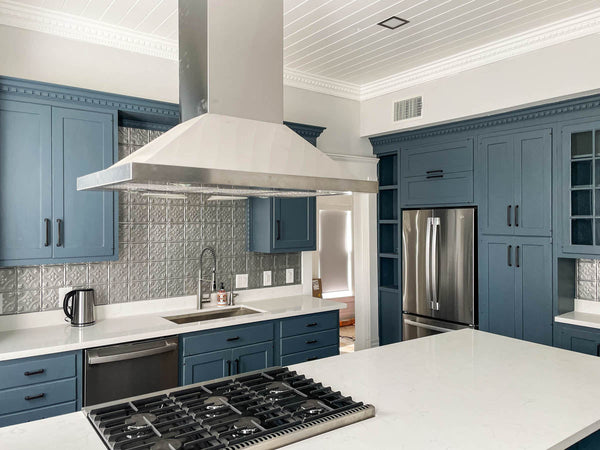When installing your range hood, it's important to ensure that all the connections are airtight. Range hoods vent cooking exhaust from your kitchen and move its air outside your home. To run at max efficiency, the air must stay inside the ductwork until it reaches the outside of your home. If your greasy kitchen air leaks back into your home, then your range hood isn't doing its job.
If the leak is significant enough, it will feel like you don't have a range hood at all. But, we want you to have a range hood that runs as efficiently as possible.
Important Note:
In our demonstration video, we use flexible ductwork for demonstration purposes. This is not recommended in your own home. Instead, use rigid ductwork. It is more durable and cost-effective than flex ductwork.

How to Seal a Range Hood Duct in 5 Easy Steps
Here's how to seal a range hood duct properly. This process happens after you mount the range hood, feed the ductwork through your wall or roof, and attach the duct adaptor or transition piece.
Extend Your Duct to the Transition Piece
Pull the duct downward and attach it to the transition piece. You may need to stretch the duct a little so it fits comfortably. Make sure the connection is secure before proceeding to the next step.
Apply Aluminum Duct Tape
Use aluminum duct tape to seal the vent. The duct might stay in place without tape, but if not, ask a friend to hold it while you apply the tape. Apply tape to the entire outside of the range hood duct connection.
Secure the Tape Firmly
This is the most critical step. Use your hands to press firmly on the tape to create an airtight seal. You want to eliminate any air bubbles or gaps between the tape and the range hood duct.
Test Before Installing Chimney
Plug in your hood and test the blower before installing the chimney. Cycle through all speeds and put your hand near the duct tape. Feel for any air seeping through the seal.
Apply Second Layer if Needed
If air leaks during testing, apply a second layer of duct tape. Attach it slightly higher than the first layer, overlapping the top edge to secure it in place.
Pro Tip:
Testing your range hood before installing the chimney is crucial. With a chimney covering the duct, it may be hard to notice air leaks for weeks or months. Then you'll have to remove the chimney to tighten the seal, which is a hassle you can avoid.
How to Keep Cold Air from Coming Through Your Range Hood Vent
There are two places where your range hood duct connects: inside your home and outside your home. In fall and winter, you don't want cold air seeping through your range hood vent. You can solve this problem with caulk.
Remove the Exterior Vent
Remove the exterior vent from your wall. If the caulking is old, you may be able to remove it by hand. Otherwise, remove dry caulking with a utility knife or scraper.
Clean Away Old Caulk
Use a utility knife or scraper to chip away remaining old caulk. Point your knife toward the wall and gently tap the base with a hammer to remove stubborn caulk.
Apply Fresh Caulking
Apply a generous layer of caulking to all outside edges. Use more rather than less - it's easier to remove excess than to add more after attachment.
Reattach the Vent
Make sure the vent is straight when reattaching to the wall. It's difficult to adjust after the caulking dries, so take your time with positioning.
Caulking Tips:
- Remove excess caulking with your finger or paper towel for a cleaner appearance
- Rest a heavy object against the vent while drying to prevent it from falling
- Caulk takes about an hour to be dry to the touch
- Leave weight against vent for a few days for complete curing
Additional Range Hood Information
A range hood damper keeps cold air, leaves, debris, and small animals from entering your ductwork from outside. It opens when you use your range hood and closes when you don't. For maximum efficiency, install it closer to the outside of your home.
Range hood vent termination refers to the caps installed on your exterior wall or roof vent. If you vent through the ceiling and roof, you need a roof cap. For exterior wall venting, you need a wall cap. These are also called termination caps or kits.
Your range hood vent should be no longer than about 30 feet of straight run, or 20 feet with two elbows. For every elbow, reduce your duct run by 5 feet. Elbows add resistance, slowing down airflow to the outside.
Remove the stainless steel chimney and tighten the seal where your range hood duct connects to the hood. Apply a second layer of aluminum duct tape to tighten the seal further. Use your range hood for a few days to test. If problems persist, you might need to clean your range hood filters or replace them to keep kitchen air moving efficiently to the outside.
Related Range Hood Installation Articles
Complete step-by-step guide for installing ducted range hoods from start to finish.
Learn about different ductwork options and which types work best for range hood installations.
Expert tips for installing range hoods in outdoor kitchen settings and challenging environments.
Need Help with Your Range Hood Installation?
Our experts are here to assist you with any range hood questions or installation challenges.
Call (877) 901-5530











